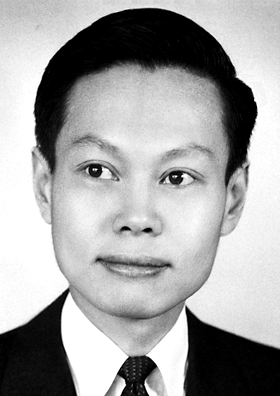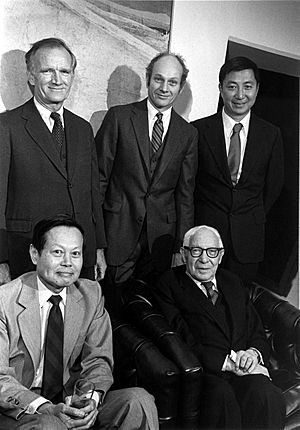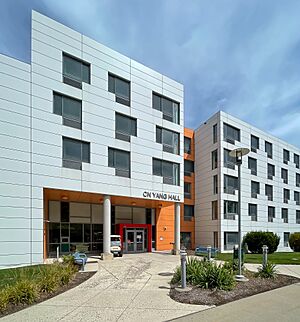Yang Chen-Ning facts for kids
Quick facts for kids
Yang Chen-Ning
|
|||||||||
|---|---|---|---|---|---|---|---|---|---|
| 楊振寧 | |||||||||

Yang in 1957
|
|||||||||
| Born | 1 October 1922 Hefei, Anhui, China
|
||||||||
| Died | 18 October 2025 (aged 103) Beijing, China
|
||||||||
| Citizenship |
|
||||||||
| Education |
|
||||||||
| Known for |
List
Yang–Baxter equation
Yang-Baxter operator Yang–Mills theory Byers-Yang theorem Landau–Yang theorem Lee–Yang theorem Lee–Yang theory Wu–Yang dictionary Wu–Yang monopole Fermi–Yang model Off-diagonal long-range order G-parity Parity violation |
||||||||
| Spouse(s) |
|
||||||||
| Children | 3 | ||||||||
| Awards |
List
Nobel Prize in Physics (1957)
Guggenheim Fellowship (1962) Fritz London Memorial Lecture (1966) Rumford Prize (1980) National Medal of Science (1986) Oskar Klein Memorial Lecture (1988) ForMemRS (1992) Benjamin Franklin Medal (1993) Bower Award (1994) Albert Einstein Medal (1995) Bogolyubov Prize (1996) Lars Onsager Prize (1999) King Faisal Prize (2001) |
||||||||
| Scientific career | |||||||||
| Fields | |||||||||
| Institutions |
|
||||||||
| Thesis | On the Angular Distribution in Nuclear Reactions and Coincidence Measurements (1948) |
||||||||
| Doctoral advisor | Edward Teller | ||||||||
| Other academic advisors | Enrico Fermi | ||||||||
| Doctoral students |
|
||||||||
| Chinese name | |||||||||
| Simplified Chinese | 杨振宁 | ||||||||
| Traditional Chinese | 楊振寧 | ||||||||
|
|||||||||
| Signature | |||||||||
 |
|||||||||
Yang Chen-Ning (also known as C. N. Yang or Frank Yang) was a brilliant Chinese scientist who studied the fundamental laws of physics. He made important discoveries in areas like how tiny particles behave and how forces work in the universe.
He and Tsung-Dao Lee received the 1957 Nobel Prize in Physics. They won for their groundbreaking work on "parity non-conservation" in weak interactions. This means they discovered that a basic rule of nature, called 'parity,' isn't always followed in certain tiny particle interactions. This idea was later proven true by the Wu experiment in 1956. Yang is also famous for developing the Yang–Mills theory with Robert Mills. This theory is super important for understanding how the smallest particles in the universe interact and is a key part of the Standard Model of particle physics.
Contents
A Brilliant Mind: Who Was Chen-Ning Yang?
Early Life and Learning
Yang Chen-Ning was born in Hefei, China, on October 1, 1922. His father, Ko-Chuen Yang, was a mathematician. Young Chen-Ning attended elementary and high school in Beijing.
In 1937, his family moved to Hefei because of the Second Sino-Japanese War. They later moved to Kunming in 1938. There, Yang studied at National Southwestern Associated University. He earned his Bachelor of Science degree in 1942. His thesis was about using group theory to understand molecular spectra.
He continued his studies, focusing on statistical mechanics. In 1944, he received his Master of Science degree from National Tsing Hua University. Yang then won a special scholarship from the United States government. This scholarship allowed him to study in America. Before leaving, he taught in a middle school and studied field theory for a year. In January 1946, Yang began his studies at the University of Chicago. He earned his Doctor of Philosophy degree in 1948.
A Career in Physics
After getting his PhD, Yang stayed at the University of Chicago for a year. He worked as an assistant to another famous physicist, Enrico Fermi. In 1949, he was invited to do research at the Institute for Advanced Study in Princeton. There, he started working closely with Tsung-Dao Lee.
Yang became a permanent member of the Institute in 1952. He was made a full professor in 1955. In 1963, he published a textbook called Elementary Particles. In 1965, he moved to Stony Brook University. There, he became a very important professor of physics. He was also the first director of the new Institute for Theoretical Physics. Today, this institute is known as the C. N. Yang Institute for Theoretical Physics.
Yang retired from Stony Brook University in 1999. He was given the title of emeritus Professor. In 2010, the university named a new dormitory building C. N. Yang Hall to honor his contributions.
Yang visited mainland China in 1971 when relations between China and the U.S. improved. He worked to help Chinese scientists rebuild their research environment. This environment had been affected by political changes during the Cultural Revolution. After retiring from Stony Brook, he returned to Beijing. He became an honorary leader at Tsinghua University. He was also a special professor at the Center for Advanced Study (CASTU). He was one of the founding members of the Shaw Prize and a visiting professor at the Chinese University of Hong Kong.
In 1986, Yang helped create the Theoretical Physics Division at the Chern Institute of Mathematics. He did this at the request of Shiing-Shen Chern. Yang was also the first president of the Association of Asia Pacific Physical Societies (AAPPS) when it started in 1989. In 1997, the AAPPS created the C.N. Yang Award to celebrate young researchers.
Important Discoveries and Theories
Yang studied many areas of physics. These included how large groups of particles behave (statistical mechanics), the properties of materials (condensed matter theory), and the smallest particles in the universe (particle physics and quantum field theory).
At the University of Chicago, Yang first worked in a lab with a particle accelerator. However, he soon realized he was better at thinking about physics ideas than doing experiments. So, he switched back to theoretical physics. His PhD research focused on understanding how atoms behave.
In 1953, Yang worked with Robert Mills to create the Yang–Mills theory. This theory is a very important way to understand how fundamental forces work between tiny particles. It's a key part of the Standard Model of particle physics, which describes all known elementary particles and forces. Robert Mills, who worked with Yang, explained that Yang had the main idea for this theory. The Scientist magazine called the Yang-Mills theory:
The foundation for current understanding of how subatomic particles interact, a contribution which has restructured modern physics and mathematics.
Yang also worked on ideas like the Fermi–Yang model in 1949. This model described certain particles called pions. In 1956, he and T. D. Lee suggested that a rule called 'parity symmetry' might not always hold true in a type of interaction called the weak interaction. This was a big surprise! Soon after, Chien-shiung Wu's team proved their idea with an experiment. For this groundbreaking discovery, Yang and Lee received the 1957 Nobel Prize in Physics. This discovery brought revolutionary change to the field of particle physics. Yang continued to explore other complex ideas about particles and forces, including neutrino theory and CP nonconservation.
In the 1970s, Yang and Wu developed new ideas about how magnetic monopoles (hypothetical particles with only one magnetic pole) could exist without strange mathematical problems. Their work helped connect physics with advanced geometry.
Yang also made many contributions to statistical mechanics, which studies how large systems of particles behave. He explored ideas like phase transitions (when a substance changes from one state to another, like water turning into ice) and how particles can be ordered in special ways. In 1967, he discovered an important equation, later called the Yang–Baxter equation. This equation is crucial for understanding certain complex systems in physics and mathematics.
When Yang retired from Stony Brook University in 1999, physicist Freeman Dyson called him "the pre-eminent stylist" of 20th-century physics, alongside Albert Einstein and Paul Dirac. Dyson said Yang "turns his least important calculations into miniature works of art, and turns his deeper speculations into masterpieces."
Life Beyond Science
Yang married Tu Chih-li, a teacher, in 1950. They had two sons and a daughter together. Tu Chih-li passed away in October 2003. In January 2005, Yang married Weng Fan, a university student. She was 54 years younger than him.
Yang became a U.S. citizen during his research in the country. He later gave up his U.S. citizenship in 2015 to become a citizen of China again. He acknowledged that the U.S. gave him many opportunities to study science.
Yang Chen-Ning celebrated his 100th birthday on October 1, 2022. He passed away in Beijing on October 18, 2025, at the age of 103.
Awards and Recognitions
Yang was recognized by many scientific groups around the world. He was elected a Fellow of the American Physical Society in 1955. He was also a member of the Chinese Academy of Sciences, the Academia Sinica, the Russian Academy of Sciences, and the Royal Society. He received honorary doctorate degrees from Princeton University (1958), Moscow State University (1992), and the Chinese University of Hong Kong (1997).

Val Fitch, James Cronin, and Samuel Chao Chung Ting (standing L–R)
- Nobel Prize in Physics (1957)
- Ten Outstanding Young Americans (1957)
- Rumford Prize (1980)
- National Medal of Science (1986)
- Oskar Klein Memorial Lecture and Medal (1988)
- Benjamin Franklin Medal for Distinguished Achievement in the Sciences of the American Philosophical Society (1993)
- Bower Award (1994)
- Albert Einstein Medal (1995)
- Lars Onsager Prize (1999)
- King Faisal International Prize (2001)
- C.N. Yang Hall, a residence hall and activity center at Stony Brook University, was dedicated in 2010.
- Marcel Grossmann Awards (2015), “for deepening Einstein’s geometrical approach to physics in the best tradition of Paul Dirac and Hermann Weyl”
- Asian Scientist 100, Asian Scientist (2016 and 2020)
See also
 In Spanish: Chen Ning Yang para niños
In Spanish: Chen Ning Yang para niños
- Yang–Mills theory
- Parity violation
- C. N. Yang Institute for Theoretical Physics
- List of Chinese Nobel laureates


